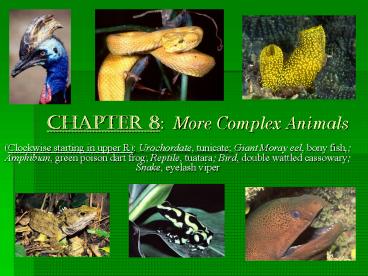Chapter 8: More Complex Animals - PowerPoint PPT Presentation
1 / 16
Title:
Chapter 8: More Complex Animals
Description:
Jointed appendages; allows for quick movement (ie) wings, legs, antennae ... Pair of legs on each segment; appendages on first segment are poisonous; help ... – PowerPoint PPT presentation
Number of Views:99
Avg rating:3.0/5.0
Title: Chapter 8: More Complex Animals
1
Chapter 8 More Complex Animals
- (Clockwise starting in upper R) Urochordate,
tunicate Giant Moray eel, bony fish, Amphibian,
green poison dart frog Reptile, tuatara Bird,
double wattled cassowary Snake, eyelash viper
2
8.1 Complex invertebrates
- Jointed-leg animals Phylum Arthropoda
- Jointed appendages allows for quick movement
(ie) wings, legs, antennae - Exoskeleton-framework outside the body
- protects from drying out, injury place for
muscles to attach - Bilateral symmetry
- Segmented body (head, thorax, abdomen)
- Right cicada
- Molting
3
8.1 cont. Right molted exoskeleton of millipede
- Molting. Shedding the exoskeleton
- Allows organism to grow
- Bottom left translucent exoskeleton of preying
mantis - Bottom right Crabs molt 27 times in their
lifetime once they have molted, it takes 3
days for new shell to harden, leaving them
extremely vulnerable
4
8.1 class crustacea
- Crayfish, shrimp, lobsters, crabs, waters fleas
and pill bugs - Mouthpart (mandible) that chew, cut food
Antennae (2 pair) for sensing and touching
Compound eye (many lenses) for peripheral vision - Above the head and thorax are
fused to create cephalothorax
5
Clockwise, starting top R shrimp, pill bug,
lobster, crab, daphnia (water flea)
- Usually have a 5 pairs of walking legs One of
those pairs is usually claw-like for grabbing and
holding (Cheliped)
6
Class Arachnids (spiders, scorpions, ticks,
harvestmen)
- Two body sections (cephalothorax-abdomen)
- 4 pairs walking legs
- Simple eyes N0 antennae
- Below left Giant emperor scorpion
Bottom right Goliath Bird eating spider
7
Arachnids cont.
- Bottom left Orb-weaver spider
- Bottom right tarantula, showing fangs (red
arrow- chelicerae) and copulatory organs on
pedipalps (purple arrow)
8
Class chilopoda
- Centipedes. (centi 100)
- Usually have no more than 30 legs
- Pair of legs on each segment appendages on first
segment are poisonous help capture food (insects)
9
Class diplopoda
- Millipedes. Two pairs of legs on each segment
slow moving - milli 1000 (but they dont have a thousand
legs) - Do NOT have poisonous claws usually eat decaying
plants
10
Class insecta
- More insects on this planet than all other
animals combined - Head-thorax-abdomen
- 2 compound eyes and 3 simple eyes
11
Insecta cont.
- Several mouthparts (specialized for sucking,
biting etc.) - One pair of antennae
- Two pairs of wings
12
Insecta cont.
- Sexual reproduction.
- Fertilized eggs usually deposited on leaves
- or branches of plants
- Some destroy (termites, moths)
- houseflies carry bacteria
- Bees produce honey pollinate flowers
13
8.1 phylum Echinoderms
- Spiny-skinned animals. (Sea Urchin, Starfish,
Sand dollar) - Sexual reproduction (egg and sperm) Asexual
reproduction (regeneration) - Five part body plan Spiny skin
- Radial symmetry Invertebrate
- Class Ophuroidea (Brittle Stars)
14
Class Echinoidea (Sand dollars, Sea Cucumbers,
Sea Urchins)
- Below L tube feet of sea urchin
- Below R Showing 5 part symmetry
15
Class Asteroidea (sea star)
- Tube feet. Allow echinoderms to move via
- water movement in and out of canals, creating
- suction for tube feet (see below)
- Regeneration has enabled
starfish to grow eleven arms
16
Class Crinoidea (Feather Stars)
- Top R Feather Star, half open, holding onto
- sponge with cirri (appendages)
- Bottom L Feather star rolled up during day
- Bottom R Noctural, open feather star































